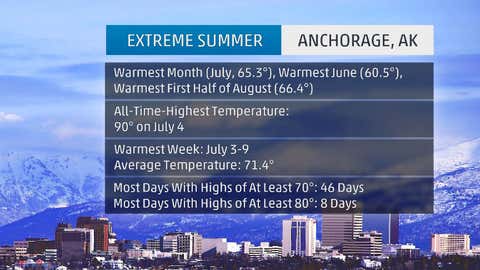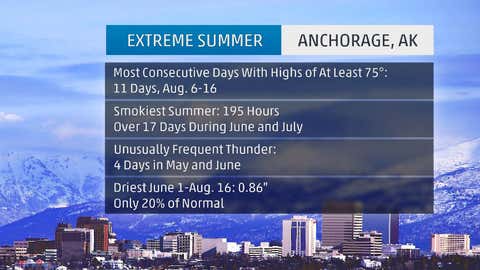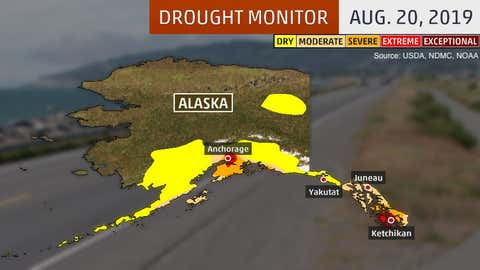
At a Glance
- Anchorage, Alaska, has arguably had the most extreme summer of any U.S. city this year.
- Heat, dry, smoke and thunder records have all been broken in the city.
- Experts say extreme summers like this one could become more common because of climate change.
When you think of extreme summer weather, which part of the United States comes to mind? Probably not Alaska, but Anchorage has arguably had the most extreme summer of any U.S. city.
Anchorage has set myriad records this summer, from heat to dry and even smoke and thunder.
Rick Thoman, a climate specialist with the International Arctic Research Center (IARC) at the University of Alaska-Fairbanks, compiled a selection of highlights from this historic summer in Anchorage.

June and July were the hottest such months on record in Anchorage. July was the city's hottest month of all-time, and Alaska as a whole very likely hit such a mark as well, according to Dr. Brian Brettschneider, an associate climate researcher with the IARC at the University of Alaska-Fairbanks. The first half of August (Aug. 1-16) also ranked as the hottest such period on record.
Anchorage chalked up its first-ever 90-degree day on the Fourth of July, smashing the previous all-time record high by 5 degrees. That resulted in the seven-day period from July 3 to 9 being the city's hottest week on record.
(MORE: July 2019 Was Earth's Hottest Month on Record)
No other year had more 70-degree days (46) or 80-degree days (eight) in Anchorage through Aug. 16. This summer also had the most consecutive days with highs of 75 degrees or warmer – 11 straight days from Aug. 6 to 16.

But it wasn't just the heat that made this summer extreme in Anchorage.
Smoke from Alaskan wildfires on the nearby Kenai Peninsula drifted into Anchorage on numerous occasions this summer, leading to unhealthy air quality and prompting the weather-observing station at Anchorage International Airport to report observations of smoke for a whopping 195 hours over 17 days in June and July. This made it the smokiest summer on record in Anchorage.
(NEWS: Alaska Wildfire Burns at Least 50 Structures)
Thunderstorms were observed on four separate May and June days in Anchorage, more such occurrences than any other year on record. Lightning strikes were even detected far to the north of Anchorage near the North Pole on Aug. 10, a rare occurrence in the few years that data have been gathered.
Despite the early-summer storms, the period from June 1 through Aug. 16 was the driest such period on record in Anchorage. The airport recorded just 0.86 inches of precipitation over two and a half months, only 20% of the rain that normally falls during that period.
So far in August, Anchorage has picked up no more than a trace of rain, and some computer forecast model guidance predicts a total of 0.01 inches the rest of the month. That would make August the driest late-summer month (July-September) on record in the city, besting August 1969, which had 0.33 inches of rain, according to Thoman.
Given this lack of rain, Anchorage was analyzed in "extreme drought", the second worst category of drought, in the weekly drought monitor analysis released August 22.
This was the first time in the 19-year history of the drought monitor analysis the Anchorage Bowl was analyzed in that dire a drought.

According to the weekly drought monitor discussion, deciduous trees and bushes dropping leaves was widespread and unprecedented in southern Alaska. Voluntary water restrictions were implemented in Kodiak, and a water emergency was declared in the village of Chignik, on the Alaskan Peninsula about 450 miles southwest of Anchorage.
Making things even stranger: despite the lack of rain, the city saw the largest amount of atmospheric moisture overhead in more than 70 years of upper-air measurements – 1.76 inches of precipitable water on Aug. 13. Bethel and Fairbanks also saw record amounts of atmospheric moisture on the same day.
Extreme summers like this one could become more common in Earth's warming climate, Brettschneider told the Associated Press. Alaska has seen "multiple decades-long increases" in temperature, he said.
"It becomes easier to have these unusual sets of conditions that now lead to records," said Brettschneider.
The recent Alaskan heat has had some positives, however. Barley and other crops are ready to harvest, Stephen Brown of the University of Alaska-Fairbanks Cooperative Extension Service told the AP.

Brown said the growing season has been extended by a month, adding that if extra days become the norm, they will expand the number of crops that can be grown in the state. He used heat radiated from his blacktop driveway to grow fruit not usually seen outside greenhouses.
"I've got a bumper crop of tomatoes and jalapeños this summer," said Brown.
On the other hand, the hot summer has stressed birch trees and left them vulnerable to leaf-eating insects.
"That gives the leaf miners opportunity to really whack them good," Brown said. "I'm looking at my lawn right now, and I need to rake leaves."
Brettschneider, however, sees mostly negative effects from the hot summer and a warming climate. Alaska looks the way it does because of the temperature regime, he told the AP, and in 50 years, it may look like Idaho.
"We should expect changes. We should expect the forests to be in different locations. We should expect wildlife to move. We should expect plants to move. And in many cases, if they can't move fast enough, we should expect them to just go away," said Brettschneider.



